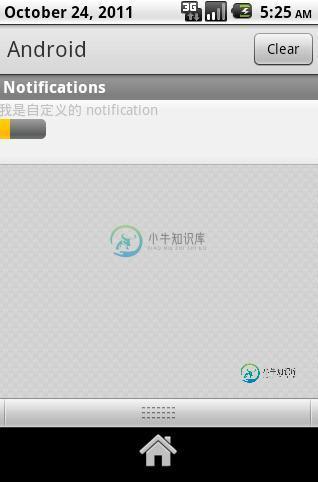Android编程自定义Notification实例分析
本文实例讲述了Android编程自定义Notification的用法。分享给大家供大家参考,具体如下:
Notification是一种让你的应用程序在不使用Activity的情况下警示用户,Notification是看不见的程序组件警示用户有需要注意的事件发生的最好途径。
作为UI部分,Notification对移动设备来说是最适合不过的了。用户可能随时都带着手机在身边。一般来说,用户会在后台打开几个程序,但不会注意它们。在这样的情形下,当发生需要注意的事件时,能够通知用户是很重要的。
Notification由NotificationManger统一管理,目前包含的能力有:
❑创建一个状态条图标。
❑在扩展的状态条窗口中显示额外的信息(和启动一个Intent)。
❑闪灯或LED。
❑电话震动。
❑发出听得见的警告声(铃声,保存的声音文件)。
自定义Notification效果图:


自定义的布局文件:
<?xml version="1.0" encoding="utf-8"?> <LinearLayout xmlns:android="http://schemas.android.com/apk/res/android" android:orientation="vertical" android:layout_width="match_parent" android:layout_height="match_parent"> <TextView android:id="@+id/tv_rv" android:layout_width="wrap_content" android:layout_height="wrap_content" android:text="haha" /> <ProgressBar style="@android:style/Widget.ProgressBar.Horizontal" android:id="@+id/pb_rv" android:layout_width="wrap_content" android:layout_height="wrap_content" /> </LinearLayout>
创建Notification:
public class CustomNotificationActivity extends Activity {
NotificationManager notificationManager;
@Override
public void onCreate(Bundle savedInstanceState) {
super.onCreate(savedInstanceState);
setContentView(R.layout.main);
//获取到系统的notificationManager
notificationManager = (NotificationManager) getSystemService(Context.NOTIFICATION_SERVICE);
}
public void click(View view ){
//实例化一个notification
String tickerText = "IP号码 设置完毕";
long when = System.currentTimeMillis();
Notification notification = new Notification(R.drawable.icon, tickerText, when);
//不能手动清理
//notification.flags= Notification.FLAG_NO_CLEAR;
//添加音乐
//notification.sound = Uri.parse("/sdcard/haha.mp3");
//设置用户点击notification的动作
// pendingIntent 延期的意图
Intent intent = new Intent(this,Bactivity.class);
PendingIntent pendingIntent = PendingIntent.getActivity(this, 0, intent, 0);
notification.contentIntent = pendingIntent;
//自定义界面
RemoteViews rv = new RemoteViews(getPackageName(), R.layout.noti_layout);
rv.setTextViewText(R.id.tv_rv, "我是自定义的 notification");
rv.setProgressBar(R.id.pb_rv, 80, 20, false);
notification.contentView = rv;
//把定义的notification 传递给 notificationmanager
notificationManager.notify(0, notification);
}
}
希望本文所述对大家Android程序设计有所帮助。
-
本文向大家介绍Android自定义ActionBar实例,包括了Android自定义ActionBar实例的使用技巧和注意事项,需要的朋友参考一下 本文实例讲述了Android自定义ActionBar的实现方法。分享给大家供大家参考。具体实现方法如下: Android 3.0及以上已经有了ActionBar的API,可以通过引入support package在3.0以下的平台引用这些API,但这儿
-
本文向大家介绍Android编程自定义Dialog的方法分析,包括了Android编程自定义Dialog的方法分析的使用技巧和注意事项,需要的朋友参考一下 本文实例讲述了Android编程自定义Dialog的方法。分享给大家供大家参考,具体如下: 功能: android 提供给我们的只有2种Dialog 即 AlertDialog & ProgressDialog 但是 Dialog 有其自身的特
-
本文向大家介绍Android编程使用Service实现Notification定时发送功能示例,包括了Android编程使用Service实现Notification定时发送功能示例的使用技巧和注意事项,需要的朋友参考一下 本文实例讲述了Android编程使用Service实现Notification定时发送功能。分享给大家供大家参考,具体如下: 更多关于Android相关内容感兴趣的读者可查看本
-
本文向大家介绍Android编程中常用适配器及自定义适配器用法实例分析,包括了Android编程中常用适配器及自定义适配器用法实例分析的使用技巧和注意事项,需要的朋友参考一下 本文实例讲述了Android编程中常用适配器及自定义适配器用法。分享给大家供大家参考,具体如下: 一、适配器. 顾名思义,就是把一些数据给弄得适当,适合以便于在View上显示。可以看作是界面数据绑定的一种理解。它所操纵的数据
-
本文向大家介绍Android编程之自定义AlertDialog(退出提示框)用法实例,包括了Android编程之自定义AlertDialog(退出提示框)用法实例的使用技巧和注意事项,需要的朋友参考一下 本文实例讲述了Android编程自定义AlertDialog(退出提示框)用法,分享给大家供大家参考,具体如下: 有时候我们需要在游戏或应用中用一些符合我们样式的提示框(AlertDialog)
-
本文向大家介绍Android种使用Notification实现通知管理以及自定义通知栏实例(示例四),包括了Android种使用Notification实现通知管理以及自定义通知栏实例(示例四)的使用技巧和注意事项,需要的朋友参考一下 示例一:实现通知栏管理 当针对相同类型的事件多次发出通知,作为开发者,应该避免使用全新的通知,这时就应该考虑更新之前通知栏的一些值来达到提醒用户的目的。例如我们手机

